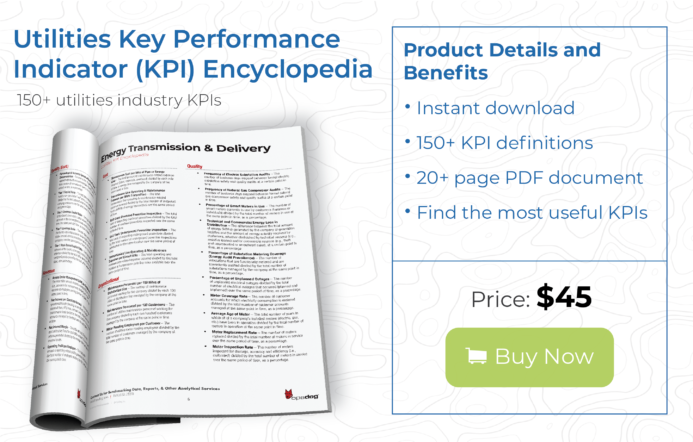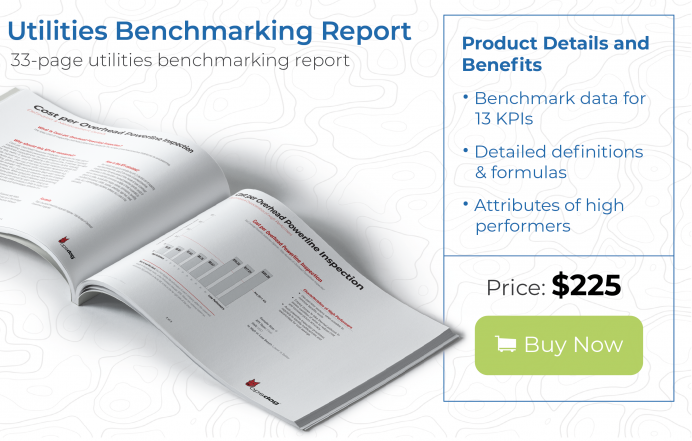The utility marketplace is changing, offering opportunities for customers to alter the way they consume resources, such as water, gas and electricity. The electric power industry has been especially affected by this shift in consumption. The advent of new choices, such as solar panels, home batteries and smart appliances, have changed how consumers manage electricity consumption in their homes and businesses. With the industry changing around you, keeping up to date on where you stand with your competitors is more important than ever to consistently acquire and retain customers. You can do so with Key Performance Indicators for electric utilities.
As households and businesses begin changing their electricity consumption, electric utility companies need to determine how to optimize costs and take advantage of observed customer demand. Using performance metrics for electric utilities, or Key Performance Indicators (KPIs), helps to benchmark your performance in this shifting marketplace and plan how to move forward, maintaining or improving customer satisfaction while keeping expenses and overhead low.
What Are Key Performance Indicators for Electric Utilities?
Key Performance Indicators for electric utilities are the quantitative values used to determine how effectively and efficiently the electric utility company achieves specific goals and objectives over a set period of time.
Crucial business questions that electric utility providers can answer by measuring and benchmarking Key Performance Indicators include:
- What percentage of sales revenue originates from renewable energy sources?
- How many hours are spent on transmission line maintenance?
- How many utility customer complaints are resolved in a timely manner?
- What is the percentage of smart meters in use?
When performing business intelligence implementations, measuring where you stand against competitors on the above items will allow your electric utility company to effectively formulate solutions to issues you may be facing. Electric utility benchmarking using KPIs will not only analyze why problems are happening, but also determine what costs those issues impose on your business. When an industry begins to undergo change, whether because of new regulations or customer behavior, it’s important to implement new strategies. Otherwise you risk falling behind more adaptable competitors and losing out on revenue and market share.
Below are 4 Key Performance Indicators for electric utility companies that managers should be measuring to stay on top of costs so that funds can be allocated to meet market demands.
Key Performance Indicators for Electric Utilities # 1: Renewable Electricity Sales as a Percentage of Total Retail Electricity Sales
First things first. What are the sources of renewable energy—a current buzzword in the electricity industry—and why are they important? Renewable energy originates from technologies that transform biomass, water, solar, wind and geothermal energy into electrical energy that can be used by consumers. Such energy sources are naturally replenished on a human timescale, thus making them far more sustainable and environmentally friendly than finite energy sources, such as natural gas and oil.
Consumers today are becoming more and more aware of renewable energy and consider it a positive when they choose an electricity provider in their area. Measuring the Renewable Electricity Sales as a Percentage of Total Retail Electricity Sales performance metric for electric utilities is important to gauge the amount of electricity sold to retail customers, measured in MWh, originating from renewable energy sources, compared to the total amount of electricity sold to retail customers. Is your Renewable Electricity Sales as a Percentage of Total Retail Electricity Sales value greater or less than the percentage your competitors have obtained? More importantly, does this percentage equal what consumers expect it to be? Measure this performance metric for electric utilities to find out!
Today being eco-friendly can easily boost your company’s reputation with consumers, so a high value for this Key Performance Indicator for electric utilities should be targeted. If you find that this performance metric for electric utilities is lagging, look to improve common issues, such as poor advertising of offered services or inaccurate forecasting of customer energy demands. Since weather can affect how efficiently renewable energy is produced, even the very location of your business can influence this value. Cloudy days can stifle solar energy absorption, and calm skies hinder wind turbines, so do plenty of research before choosing where to construct your electric energy facility.
Deciding how to invest in renewable energy requires a well-designed strategy and plan that, when implemented properly, can boost sales, bring in new customers and open your business to new partnerships with industry organizations, such as the Office of Energy Efficiency and Renewable Energy (EERE).
Key Performance Indicators for Electric Utilities # 2: Transmission Line Operating & Maintenance Expense per MWh Transmitted
One of the worst things that can happen in the middle of working on a computer is a sudden power outage, especially if you were working on something pressing or time sensitive. Poor maintenance practices can spell disaster for an electricity distribution company. Consequences can include expensive repairs, low customer satisfaction rates and high volumes of customer attrition. Use the Transmission Line Operating & Maintenance Expense per MWh Transmitted Key Performance Indicator for electricity distribution companies to measure the division between the transmission line operating & maintenance-related expense incurred by the company and the total number of megawatt hours (MWh) of energy transmitted. Electric utilities companies should track and analyze this metric to ensure that they aren’t pouring money into improper operating practices that are causing more problems than they are fixing.
Implement targeted employee training and periodically reevaluate the utility company’s operating and maintenance practices to balance staffing levels and reduce inefficiencies, such as poor equipment maintenance and high transmission line repair rates. Although keeping the value of this Key Performance Indicator for electricity distribution companies low can reduce expenses (which is important), you can also expect customer satisfaction to rise as improved transmission line maintenance practices reduce potential power supply issues. Money saved through lower operating and maintenance expenses can be allocated to new ventures, more targeted advertising and investments in the area’s renewable energy sources.
Key Performance Indicators for Electric Utilities # 3: Percentage of Utilities Customer Complaints Resolved Within 50 Days
It’s nearly impossible to run a system to meet demand 24/7, 365 days a year. Power outages and interruptions happen. Consumers, however, don’t just complain about power outages: the cost of the electricity provided can be an issue as well. To be as robust as possible, your electric utility benchmarking effort should use the Percentage of Utilities Customer Complaints Resolved Within 50 Days performance metric for electric utilities to measure how you stack up to your competitors when it comes to the number of utilities customer complaints resolved in 50 business days or less.
A low value for this Key Performance Indicator for electric utilities typically indicates poor employee performance, inadequate staffing at call centers and issues in the complaint resolution process (e.g., complicated forms or poor triage practices). A large backlog of poorly managed customer complaints may lead to poor customer satisfaction, increased customer disputes and, in extreme cases, legal action against the company. This can cost the company large sums of money and generate negative press. If competitors are handling complaints in a timely manner with standardized processes, they may easily snatch up angry customers from you before you even reach their compliant in the backlog.
Key Performance Indicators for Electric Utilities # 4: Percentage of Smart Meters in Use
The move away from “dumb” electricity meters—those that report only monthly use and require meter readers to monitor—towards “smart” meters allows consumers to become more aware of their electricity use. Why are smart meters useful for electricity distribution companies? These meters not only save money on labor expenses—the more meters automatically transmitting information to the company, the fewer meter readers are needed—but can also refine meter readers’ current routes. This increases productivity by limiting meter readers’ time in the field and reduces manipulation of meter information.
The Percentage of Smart Meters in Use performance metric for electric utilities measures the number of smart meters currently in use by customers compared to the total number of meters in use. As useful as smart meters can be, however, not all consumers are happy about using them because of concerns about broken meters producing inaccurate measurement of energy consumption, billing errors as a result of incorrectly installed meters and potentially lax cyber security for the information that smart meters gather and send via their wireless network. To alleviate these concerns and reduce instances of customer dissatisfaction, fully explain to customers the benefits of using smart meters.
Key Performance Indicators for Electric Utilities Thoughts and Resources
Electric utility benchmarking and business intelligence efforts will help you put your business’s operational processes into perspective within the marketplace, opening new growth opportunities. As individual households and businesses alike pay increasing attention to their energy consumption, electric providers will need to continuously compare themselves to competitors to ensure they remain a top choice for all types of customers.
Although you’ve reached the end of this article, we’ve only just touched the surface of Key Performance Indicators for electric utilities. For a more complete list of utility KPIs, download our comprehensive Utilities Key Performance Indicator Catalog here.
Do you need help lowering expenses and standing out in the constantly shifting climate of the utilities industry? Contact us for information concerning our Benchmarking Research and business intelligence implementation service and we’ll quickly help you benchmark your business and provide you with presentation-ready deliverables at an affordable price.

